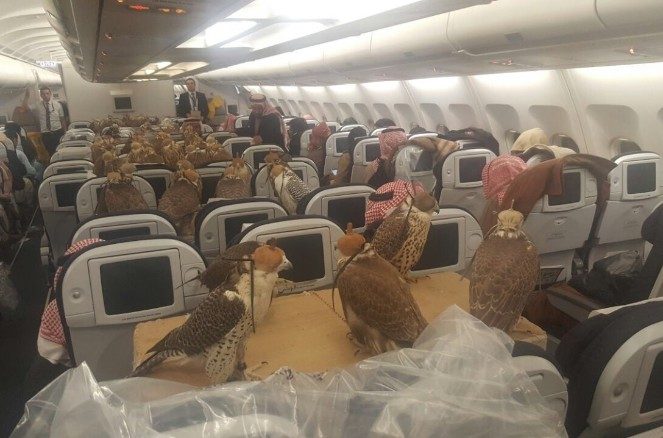When Birds Fly: The Role Airlines Play in Falconry
Share

APEX Insight: When a photo of several dozen falcons on an airplane went viral last week, it called attention to falconry and airlines’ role in transporting the birds of prey. Lufthansa has even patented a bird stand called the Falcon Master, which it says is “a safe and comfortable solution for both owner and falcon.”
The cabin of a commercial airliner is one of the last places you might expect to encounter a bird of prey. Unless, of course, you’re flying between certain areas in the Middle East. Last week, a photo of a cast of falcons on an airplane went viral, calling attention to falconry and airlines’ role in transporting the birds of prey to hunting destinations and racing competitions.
Falconry has existed for thousands of years, and is still a popular method of hunting in the UAE. Well-heeled falconers fly internationally so their birds can hunt prey that can no longer be found locally. Falcon racing has more recently emerged as a competitive sport in the Gulf region – falconers spend months training their birds, by getting them to chase cars or remote-controlled airplanes, and then transport them to competitions like the Fazza Championships for Falconry and The President Cup. This has led to an interesting quirk in the luggage policies of major Middle Eastern carriers: Pet carrier rules include provisions for falcons as carry-on companions. A happy falcon means a happy falconer; and happy falconers can lead to brand loyalty.

Besides allowing avian predators in the cabin, Lufthansa – which recently inked a codesharing deal with Etihad – has focused on improving the passenger experience for falcons. According to Lufthansa Technik, the Falcon Master “enables VIPs to bring their falcons on board while keeping them nearby in the cabin during flight – a safe and comfortable solution for both owner and falcon.” It’s common to see falcon stands that look like small plinths, but the Falcon Master more closely resembles a horizontal rod, wrapped in artificial turf, with a shallow plexiglass tub underneath – similar to what you’d see at a Japanese owl cafe. Lufthansa’s patented bird stand, which launched in 2014, is moved through the cabin like a trolley, and installed over a row of folded seats upon its adjustable legs.
Rules around falcon transport vary by airline, point of departure and destination. Emirates does not allow animals inside the cabin, with the exception of falcons, which are only permitted on flights between Dubai and certain destinations in Pakistan, and guide dogs. Qatar’s economy-class passengers are permitted to carry one falcon each with them on board, up to a maximum of six falcons per economy cabin. Etihad allows premium-class passengers to be accompanied by up to two falcons per seat, with the option to purchase an extra seat for up to two more falcons. In all cases the birds must be hooded and premium excess baggage fees apply.


